英语教学理论
- 格式:doc
- 大小:48.50 KB
- 文档页数:4
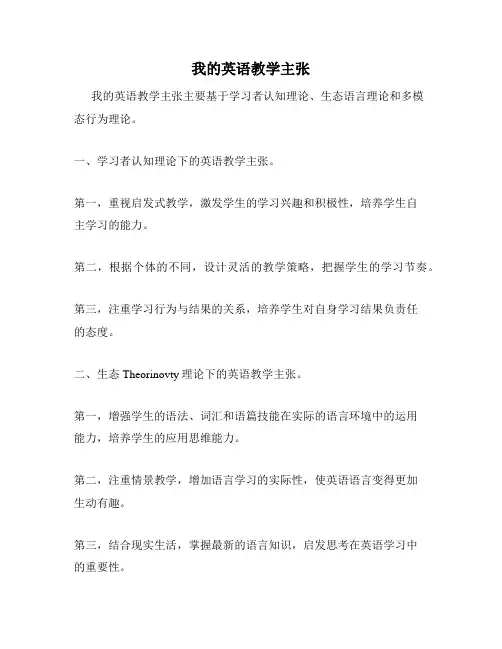
我的英语教学主张
我的英语教学主张主要基于学习者认知理论、生态语言理论和多模
态行为理论。
一、学习者认知理论下的英语教学主张。
第一,重视启发式教学,激发学生的学习兴趣和积极性,培养学生自
主学习的能力。
第二,根据个体的不同,设计灵活的教学策略,把握学生的学习节奏。
第三,注重学习行为与结果的关系,培养学生对自身学习结果负责任
的态度。
二、生态 Theorinovty理论下的英语教学主张。
第一,增强学生的语法、词汇和语篇技能在实际的语言环境中的运用
能力,培养学生的应用思维能力。
第二,注重情景教学,增加语言学习的实际性,使英语语言变得更加
生动有趣。
第三,结合现实生活,掌握最新的语言知识,启发思考在英语学习中
的重要性。
三、多模态行为理论下的英语教学主张。
第一,重视感官学习,重点培养学生英语学习的听、说、读、写技能。
第二,创造式教学,引导学生跳脱单一模式,培养独立思考与创新能力。
第三,培养学生社会交往能力,使英语学习变得更加具体化和实际化。

第1篇Introduction:English education has been a significant part of global education for decades. The development of English education theory and teachingpractice has been constantly evolving to meet the needs of students in different contexts. This paper aims to explore the key theories and practices in English education, highlighting their importance in achieving effective language learning outcomes.I. Theories of English Education1. Behaviorist Theory:Behaviorist theory, represented by B.F. Skinner, suggests that language learning is a process of habit formation. Students acquire language by responding to stimuli and being reinforced for correct responses. This theory emphasizes the importance of repetition, practice, and positive reinforcement in language learning.2. Cognitive Theory:Cognitive theory, advocated by Noam Chomsky, focuses on the internal mental processes of language acquisition. This theory argues that learners have an innate capacity to acquire language and that they construct their own understanding of language through internal cognitive processes.3. Sociocultural Theory:Sociocultural theory, proposed by Lev Vygotsky, emphasizes the role of social interaction in language learning. This theory suggests that learners develop language skills through interaction with more knowledgeable others, such as teachers and peers. Collaborative learning, scaffolding, and peer tutoring are essential components of this theory.4. Humanistic Theory:Humanistic theory, represented by Carl Rogers, emphasizes the importance of individual learning styles and self-concept. This theory emphasizesthe role of the learner's emotions, motivation, and personal values in language learning. Teachers are encouraged to create a supportive and empathetic learning environment that fosters intrinsic motivation.II. Teaching Practices in English Education1. Task-Based Language Teaching (TBLT):TBLT is an approach that focuses on authentic communication tasks. Teachers design tasks that require students to use the target language in real-life contexts. This approach encourages students to develop their language skills through interaction and collaboration.2. Communicative Language Teaching (CLT):CLT emphasizes the importance of communication in language learning. Teachers create activities that promote interaction and allow students to practice language in a meaningful context. This approach helps students develop fluency and accuracy in the target language.3. Content-Based Instruction (CBI):CBI integrates content from other disciplines into language learning. This approach allows students to learn language while acquiring knowledge in a specific subject area. CBI helps students develop language skills that are relevant to their academic and professional lives.4. Technology-Enhanced Language Learning (TELL):TELL utilizes technology to support language learning. Teachers incorporate digital tools, such as interactive whiteboards, educational software, and online resources, into their lessons. This approach enhances student engagement and provides opportunities for personalized learning.III. Importance of Theories and Practices in English Education1. Achieving Effective Language Learning Outcomes:By understanding and implementing various theories and practices, teachers can create a more effective learning environment that caters to the diverse needs of students. This leads to improved language proficiency and overall learning outcomes.2. Addressing Individual Learning Styles:Different theories and practices cater to different learning styles. By incorporating a variety of approaches, teachers can ensure that students with diverse learning preferences can succeed in their language learning journey.3. Fostering Motivation and Engagement:Effective teaching practices, such as TBLT and CLT, encourage students to actively engage in language learning. This promotes intrinsic motivation and helps students develop a genuine interest in the target language.4. Preparing Students for Real-Life Situations:By incorporating authentic tasks and content-based instruction, teachers prepare students for real-life communication and academic challenges. This helps students develop language skills that are applicable in various contexts.Conclusion:English education theory and teaching practice are essential components of effective language learning. By understanding and implementing various theories and practices, teachers can create a more engaging and supportive learning environment for their students. This leads to improved language proficiency, motivation, and overall success in English education.第2篇English language education has become an integral part of the educational landscape worldwide. The field is characterized by a rich tapestry of theories and pedagogical practices that aim to facilitateeffective language learning. This paper explores some key theoretical frameworks and their application in teaching English, providing insights into how these theories can be practically implemented in the classroom.Theoretical Frameworks in English Language Education1. Theoretical Approaches to Language Learning- Behaviorist Theory: This theory, rooted in the work of B.F. Skinner, posits that language learning is a process of habit formation. Through repetition and reinforcement, learners acquire language skills. Teachers employing this approach focus on explicit instruction, drilling, and repetition.- Cognitive Theory: Cognitive psychologists like Lev Vygotsky emphasize the role of mental processes in language learning. This theory suggests that learners construct knowledge through social interactionand collaboration. Teachers using this approach create opportunities for learners to engage in meaningful conversations and activities that promote critical thinking.- Social Constructivist Theory: Proposed by Lev Vygotsky and further developed by others, this theory emphasizes the importance of social interaction and cultural context in language learning. Learnersconstruct meaning through their interactions with others, and teachers facilitate these interactions by creating a supportive and collaborative learning environment.- Humanistic Theory: This approach, influenced by the work of Carl Rogers and Abraham Maslow, focuses on the emotional and psychological needs of the learner. Teachers employing humanistic techniques aim to create a positive and empathetic learning environment that fosters self-esteem and intrinsic motivation.2. Methodologies in English Language Teaching- Direct Method: Also known as the audio-lingual method, this approach emphasizes oral communication and uses the target language asmuch as possible. Teachers focus on vocabulary and grammar in a structured and systematic manner.- Audio-Lingual Method: Similar to the direct method, this approach uses audio-visual aids and repetition to teach language skills. It focuses on the mimicry and repetition of phrases and sentences.- Communicative Language Teaching (CLT): CLT emphasizes communication as the primary goal of language learning. Teachers design activitiesthat allow learners to practice language in real-life contexts, focusing on fluency rather than accuracy.- Task-Based Language Teaching (TBLT): TBLT involves learners in completing tasks that require them to use the language in a meaningful way. Tasks are designed to be authentic and relevant to the learners' lives.Pedagogical Practices in English Language Education1. Task-Based LearningTask-based learning involves designing activities that require learners to complete a specific task using the target language. These tasks should be meaningful, relevant, and engaging. For example, a teacher might assign a group project where students have to create a presentation about a cultural event in English.2. Flipped ClassroomThe flipped classroom model involves students watching instructional videos or completing readings at home, and then using class time for interactive activities and discussions. This approach allows teachers to focus on providing individualized attention and guidance.3. Technology IntegrationTechnology can be a powerful tool in English language education. Teachers can use various software and apps to create interactive lessons, provide feedback, and track student progress. For instance, educationalplatforms like Duolingo and Rosetta Stone offer interactive language learning experiences.4. Collaborative LearningCollaborative learning encourages students to work together in pairs or groups to achieve a common goal. This approach promotes communication skills, teamwork, and critical thinking. Teachers can facilitate collaborative learning by assigning group projects or discussion activities.5. Authentic MaterialsUsing authentic materials, such as newspapers, magazines, and videos, can make learning more engaging and relevant. Authentic materials allow learners to encounter the target language in its natural context and develop their language skills in a practical manner.ConclusionTheoretical frameworks and pedagogical practices in English language education are essential tools for teachers seeking to create effective and engaging learning experiences. By understanding and applying these theories and practices, teachers can help learners develop their language skills in a meaningful and enjoyable way. As the field of English language education continues to evolve, it is crucial for educators to remain adaptable and open to new ideas and approaches.第3篇Introduction:English education plays a crucial role in the globalized world, as it serves as a bridge for communication, culture, and knowledge exchange. This paper aims to explore the theoretical framework and teaching practices in English education, highlighting the importance of integrating theory with practical strategies to enhance learning outcomes. By analyzing various theories and practices, this paper will provide insights into effective English language teaching methods and their application in real-life classroom settings.I. Theoretical Framework1. Behaviorist TheoryBehaviorist theory, developed by B.F. Skinner, emphasizes the role of environmental factors and reinforcement in learning. In English education, this theory suggests that learners acquire language through repetition, imitation, and reinforcement. Teachers can implement this theory by using techniques such as rote learning, repetition drills, and positive reinforcement to encourage language practice.2. Cognitive TheoryCognitive theory, proposed by Jean Piaget, focuses on the internal mental processes involved in learning. According to this theory, learners construct knowledge through their interactions with the environment. In English education, teachers can apply cognitive theory by promoting critical thinking, problem-solving, and active learning. Techniques such as project-based learning, inquiry-based learning, and cooperative learning can be utilized to foster students' cognitive development.3. Communicative Language Teaching (CLT)Communicative Language Teaching is a method that emphasizes communication as the primary goal of language learning. This theory suggests that learners should be provided with opportunities to engagein real-life communication activities. Teachers can incorporate CLT into their English classes by using activities such as role-playing, debates, and discussions to enhance students' speaking and listening skills.4. Humanistic TheoryHumanistic theory, as proposed by Carl Rogers, emphasizes the importance of the learner's emotional and psychological well-being in the learning process. In English education, this theory suggests that teachers should create a supportive and positive learning environment that fosters students' self-esteem and autonomy. Techniques such as student-centeredlearning, self-assessment, and reflection can be employed to promote students' personal development.II. Teaching Practices1. Needs AnalysisBefore designing a lesson plan, it is essential for teachers to conduct a needs analysis to identify the specific language requirements and learning objectives of their students. This involves assessing students' proficiency levels, interests, and learning styles. Based on this information, teachers can tailor their teaching methods and materials to meet the individual needs of their students.2. Language Skills DevelopmentIn English education, it is crucial to focus on the development of all four language skills: listening, speaking, reading, and writing. Teachers can implement various activities and techniques to enhance these skills. For example, listening exercises can include listening to audio clips or watching videos, speaking activities can involve group discussions or presentations, reading tasks can include reading articles or analyzing texts, and writing assignments can range from short essays to creative writing.3. Task-Based Language Teaching (TBLT)Task-based language teaching involves designing lessons around authentic tasks that require students to use the language in real-life contexts. This approach encourages students to engage in meaningful communication and develop language skills naturally. Teachers can create tasks that simulate real-life situations, such as role-plays, simulations, or problem-solving activities.4. Technology IntegrationIncorporating technology into English education can enhance students' learning experiences and engagement. Teachers can utilize variousdigital tools and resources, such as online platforms, educational apps, and multimedia materials, to facilitate language learning. For instance,students can use language learning software to practice grammar or vocabulary, or teachers can create interactive lessons using multimedia presentations.5. Assessment and FeedbackRegular assessment and feedback are essential for monitoring students' progress and identifying areas for improvement. Teachers can employ various assessment methods, such as formative and summative assessments, quizzes, and projects. Constructive feedback should be provided to students to guide their learning and help them develop their language skills.Conclusion:In conclusion, the theoretical framework and teaching practices in English education encompass a range of theories and techniques that can be effectively applied in the classroom. By integrating these theories with practical strategies, teachers can create a dynamic and engaging learning environment that promotes language acquisition and personal development. Continuous reflection and adaptation of teaching methods are essential to meet the evolving needs of students and ensureeffective English education.。
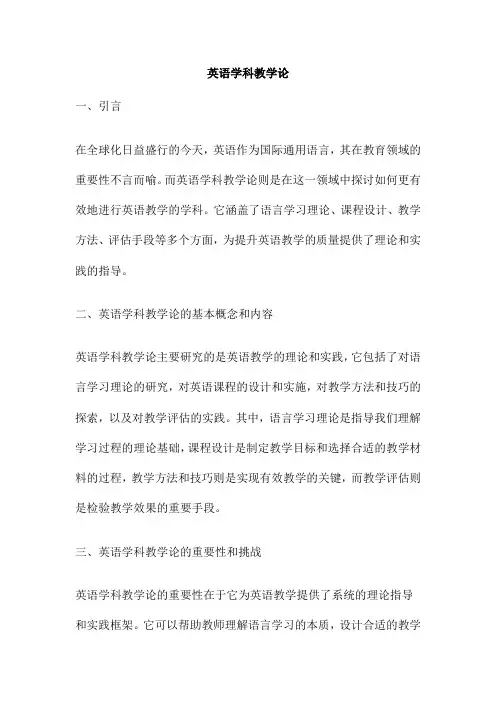
英语学科教学论一、引言在全球化日益盛行的今天,英语作为国际通用语言,其在教育领域的重要性不言而喻。
而英语学科教学论则是在这一领域中探讨如何更有效地进行英语教学的学科。
它涵盖了语言学习理论、课程设计、教学方法、评估手段等多个方面,为提升英语教学的质量提供了理论和实践的指导。
二、英语学科教学论的基本概念和内容英语学科教学论主要研究的是英语教学的理论和实践,它包括了对语言学习理论的研究,对英语课程的设计和实施,对教学方法和技巧的探索,以及对教学评估的实践。
其中,语言学习理论是指导我们理解学习过程的理论基础,课程设计是制定教学目标和选择合适的教学材料的过程,教学方法和技巧则是实现有效教学的关键,而教学评估则是检验教学效果的重要手段。
三、英语学科教学论的重要性和挑战英语学科教学论的重要性在于它为英语教学提供了系统的理论指导和实践框架。
它可以帮助教师理解语言学习的本质,设计合适的教学课程,选择有效的教学方法,以及实施科学的教学评估。
然而,随着教育的不断发展和改革,英语学科教学论也面临着许多挑战。
例如,如何平衡知识传授和能力培养,如何处理技术与传统教学的关系,如何应对不同学生的需求等问题都需要我们深入研究和探讨。
四、结论英语学科教学论是指导我们进行英语教学的重要学科,它为我们提供了理论和实践的双重指导。
然而,面对教育的不断发展和改革,我们也需要不断地更新我们的知识和理解,以适应新的挑战。
未来,我们期待英语学科教学论能够为我们提供更多的启示和帮助,以推动我们的英语教学达到更高的水平。
论英语学科核心素养下的初中英语阅读教学在英语学科核心素养的视角下,初中英语阅读教学具有重要的地位。
英语阅读不仅能帮助学生获取信息、拓展视野,也能帮助他们增强语感、积累词汇,提高英语综合能力。
然而,当前的初中英语阅读教学仍存在一些问题,如过度强调词汇和语法,忽视了学生的思维能力和文化意识的培养。
因此,我们需要重新审视初中英语阅读教学,探讨如何培养学生的核心素养。
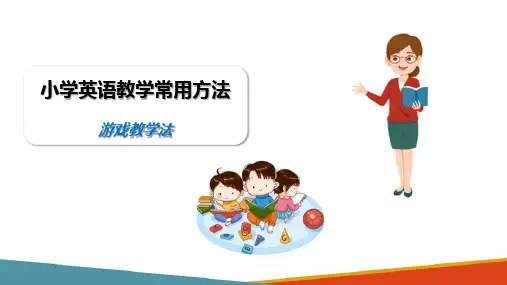
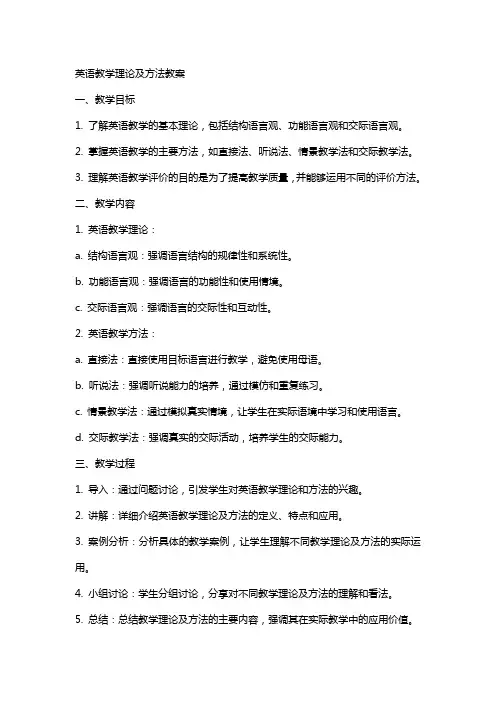
英语教学理论及方法教案一、教学目标1. 了解英语教学的基本理论,包括结构语言观、功能语言观和交际语言观。
2. 掌握英语教学的主要方法,如直接法、听说法、情景教学法和交际教学法。
3. 理解英语教学评价的目的是为了提高教学质量,并能够运用不同的评价方法。
二、教学内容1. 英语教学理论:a. 结构语言观:强调语言结构的规律性和系统性。
b. 功能语言观:强调语言的功能性和使用情境。
c. 交际语言观:强调语言的交际性和互动性。
2. 英语教学方法:a. 直接法:直接使用目标语言进行教学,避免使用母语。
b. 听说法:强调听说能力的培养,通过模仿和重复练习。
c. 情景教学法:通过模拟真实情境,让学生在实际语境中学习和使用语言。
d. 交际教学法:强调真实的交际活动,培养学生的交际能力。
三、教学过程1. 导入:通过问题讨论,引发学生对英语教学理论和方法的兴趣。
2. 讲解:详细介绍英语教学理论及方法的定义、特点和应用。
3. 案例分析:分析具体的教学案例,让学生理解不同教学理论及方法的实际运用。
4. 小组讨论:学生分组讨论,分享对不同教学理论及方法的理解和看法。
5. 总结:总结教学理论及方法的主要内容,强调其在实际教学中的应用价值。
四、教学评价1. 平时成绩:通过课堂参与、小组讨论和作业完成情况进行评估。
2. 小组报告:学生分组进行教学案例分析报告,展示对教学理论及方法的理解和应用。
3. 期末考试:设置相关考试题目,测试学生对英语教学理论及方法的掌握程度。
五、教学资源1. 教材:英语教学理论及方法相关书籍和教材。
2. 多媒体课件:制作多媒体课件,辅助讲解和展示教学内容。
3. 网络资源:利用网络资源,提供更多的教学案例和相关信息。
4. 教学道具:准备一些教学道具,如图片、卡片等,用于情景模拟和练习。
六、教学活动设计1. 案例分析:选取实际的教学案例,让学生分析并判断所使用的教学理论和方法。
2. 角色扮演:学生分组进行角色扮演,模拟教学场景,运用所学的教学方法。
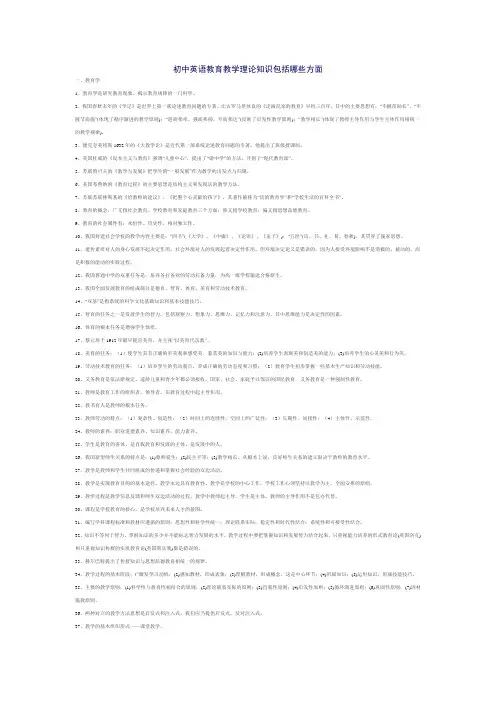
初中英语教育教学理论知识包括哪些方面一、教育学1、教育学是研究教育现象、揭示教育规律的一门科学。
2、我国春秋末年的《学记》是世界上第一部论述教育问题的专著。
比古罗马昆体良的《论演况家的教育》早约三百年。
其中的主要思想有:“不揠苗助长”、“不陵节而施”(体现了循序渐进的教学原则);“道而弗牵、强而弗抑、开而弗达”(反映了启发性教学原则);“教学相长”(体现了教师主导作用与学生主体作用相统一的教学规律)。
3、捷克夸美纽斯1632年的《大教学论》是近代第一部系统论述教育问题的专著。
他提出了班级授课制。
4、美国杜威的《民本主义与教育》强调“儿童中心”,提出了“做中学”的方法,开创了“现代教育派”。
5、苏联赞可夫的《教学与发展》把学生的“一般发展”作为教学的出发点与归属。
6、美国布鲁纳的《教育过程》的主要思想是结构主义和发现法的教学方法。
7、苏联苏霍林斯基的《给教师的建议》、《把整个心灵献给孩子》,其著作被称为“活的教育学”和“学校生活的百科全书”。
8、教育的概念:广义指社会教育、学校教育和家庭教育三个方面;狭义指学校教育;偏义指思想品德教育。
9、教育的社会属性有:永恒性、历史性、相对独立性。
10、我国封建社会学校的教学内容主要是:“四书”(《大学》、《中庸》、《论语》、《盂子》);“五经”(诗、书、礼、易、春秋)。
其贯穿了儒家思想。
11、遗传素质对人的身心发展不起决定作用,社会环境对人的发展起着决定性作用。
但环境决定论又是错误的,因为人接受环境影响不是消极的、被动的,而是积极的能动的实践过程。
12、我国普通中学的双重任务是:培养各行各业的劳动后备力量;为高一级学校输送合格新生。
13、我国全面发展教育的组成部分是德育、智育、体育、美育和劳动技术教育。
14、“双基”是指系统的科学文化基础知识和基本技能技巧。
15、智育的任务之一是发展学生的智力,包括观察力、想象力、思维力、记忆力和注意力,其中思维能力是决定性的因素。
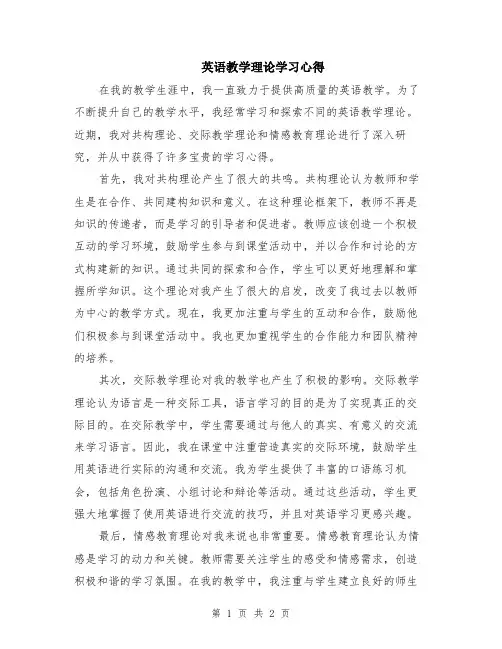
英语教学理论学习心得在我的教学生涯中,我一直致力于提供高质量的英语教学。
为了不断提升自己的教学水平,我经常学习和探索不同的英语教学理论。
近期,我对共构理论、交际教学理论和情感教育理论进行了深入研究,并从中获得了许多宝贵的学习心得。
首先,我对共构理论产生了很大的共鸣。
共构理论认为教师和学生是在合作、共同建构知识和意义。
在这种理论框架下,教师不再是知识的传递者,而是学习的引导者和促进者。
教师应该创造一个积极互动的学习环境,鼓励学生参与到课堂活动中,并以合作和讨论的方式构建新的知识。
通过共同的探索和合作,学生可以更好地理解和掌握所学知识。
这个理论对我产生了很大的启发,改变了我过去以教师为中心的教学方式。
现在,我更加注重与学生的互动和合作,鼓励他们积极参与到课堂活动中。
我也更加重视学生的合作能力和团队精神的培养。
其次,交际教学理论对我的教学也产生了积极的影响。
交际教学理论认为语言是一种交际工具,语言学习的目的是为了实现真正的交际目的。
在交际教学中,学生需要通过与他人的真实、有意义的交流来学习语言。
因此,我在课堂中注重营造真实的交际环境,鼓励学生用英语进行实际的沟通和交流。
我为学生提供了丰富的口语练习机会,包括角色扮演、小组讨论和辩论等活动。
通过这些活动,学生更强大地掌握了使用英语进行交流的技巧,并且对英语学习更感兴趣。
最后,情感教育理论对我来说也非常重要。
情感教育理论认为情感是学习的动力和关键。
教师需要关注学生的感受和情感需求,创造积极和谐的学习氛围。
在我的教学中,我注重与学生建立良好的师生关系,关心他们的需求和感受。
我鼓励他们表达自己的情感,并且尊重他们的学习风格和个人差异。
通过情感教育,学生感受到我的关怀和支持,更加积极地参与到课堂活动中。
综上所述,通过学习共构理论、交际教学理论和情感教育理论,我对自己的英语教学产生了积极的影响。
我更注重与学生的合作和互动,在课堂中创造了真实的交际环境。
我也更加关注学生的情感需求,并与他们建立了良好的师生关系。
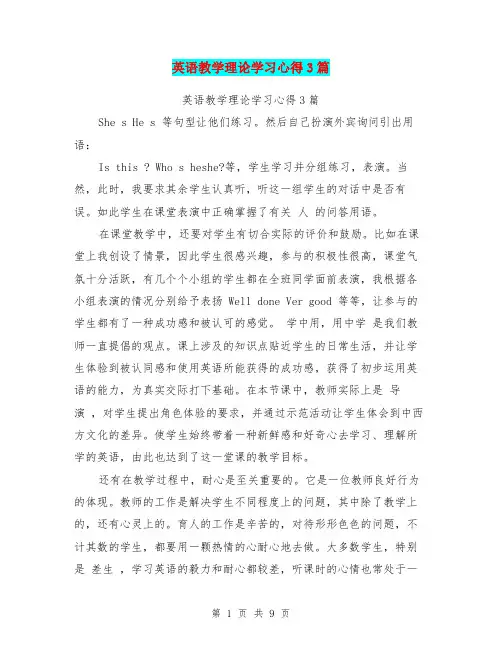
英语教学理论学习心得3篇英语教学理论学习心得3篇She s He s 等句型让他们练习。
然后自己扮演外宾询问引出用语:Is this ? Who s heshe?等,学生学习并分组练习,表演。
当然,此时,我要求其余学生认真听,听这一组学生的对话中是否有误。
如此学生在课堂表演中正确掌握了有关人的问答用语。
在课堂教学中,还要对学生有切合实际的评价和鼓励。
比如在课堂上我创设了情景,因此学生很感兴趣,参与的积极性很高,课堂气氛十分活跃,有几个个小组的学生都在全班同学面前表演,我根据各小组表演的情况分别给予表扬 Well done Ver good 等等,让参与的学生都有了一种成功感和被认可的感觉。
学中用,用中学是我们教师一直提倡的观点。
课上涉及的知识点贴近学生的日常生活,并让学生体验到被认同感和使用英语所能获得的成功感,获得了初步运用英语的能力,为真实交际打下基础。
在本节课中,教师实际上是导演,对学生提出角色体验的要求,并通过示范活动让学生体会到中西方文化的差异。
使学生始终带着一种新鲜感和好奇心去学习、理解所学的英语,由此也达到了这一堂课的教学目标。
还有在教学过程中,耐心是至关重要的。
它是一位教师良好行为的体现。
教师的工作是解决学生不同程度上的问题,其中除了教学上的,还有心灵上的。
育人的工作是辛苦的,对待形形色色的问题,不计其数的学生,都要用一颗热情的心耐心地去做。
大多数学生,特别是差生,学习英语的毅力和耐心都较差,听课时的心情也常处于一种抑制状态,觉得学习无聊。
因此,在课堂上除了多给他们参与活动和发言的机会外,特别是对他们提出的问题和质疑,哪怕再浅显也应耐心回答,并予以支持和表扬,这样对消除他们心头的恐惧感和失落感十分有利总之,英语学习,兴趣为先。
学生语言能力的高低在很大程度上受制于英语学习兴趣的程度。
很难想象失去了兴趣还能怎样培养交际能力。
所以,作为英语教师,一方面要向学生传授语言知识并使他们掌握技能,另一方面更要重视培养和保持学生对这门学科的兴趣,获得事半功倍的效果。
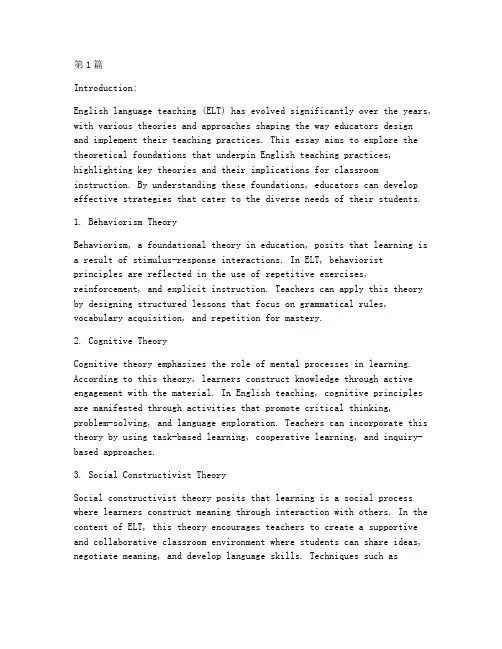
第1篇Introduction:English language teaching (ELT) has evolved significantly over the years, with various theories and approaches shaping the way educators designand implement their teaching practices. This essay aims to explore the theoretical foundations that underpin English teaching practices, highlighting key theories and their implications for classroom instruction. By understanding these foundations, educators can develop effective strategies that cater to the diverse needs of their students.1. Behaviorism TheoryBehaviorism, a foundational theory in education, posits that learning is a result of stimulus-response interactions. In ELT, behavioristprinciples are reflected in the use of repetitive exercises, reinforcement, and explicit instruction. Teachers can apply this theory by designing structured lessons that focus on grammatical rules, vocabulary acquisition, and repetition for mastery.2. Cognitive TheoryCognitive theory emphasizes the role of mental processes in learning. According to this theory, learners construct knowledge through active engagement with the material. In English teaching, cognitive principles are manifested through activities that promote critical thinking, problem-solving, and language exploration. Teachers can incorporate this theory by using task-based learning, cooperative learning, and inquiry-based approaches.3. Social Constructivist TheorySocial constructivist theory posits that learning is a social process where learners construct meaning through interaction with others. In the context of ELT, this theory encourages teachers to create a supportive and collaborative classroom environment where students can share ideas, negotiate meaning, and develop language skills. Techniques such asproject-based learning, discussion forums, and peer feedback are effective in promoting social constructivist learning.4. Humanistic TheoryHumanistic theory emphasizes the importance of personal growth, self-awareness, and emotional well-being in the learning process. In English teaching, this theory suggests that educators should focus on creating a positive and nurturing classroom atmosphere that values individual differences and promotes student autonomy. Techniques such as reflective writing, self-assessment, and student-centered activities are aligned with humanistic principles.5. Communicative Language Teaching (CLT)Communicative Language Teaching is an approach that emphasizes communication as the primary goal of language learning. This theory suggests that learners should engage in meaningful and authentic language use in order to develop their language skills. Teachers can implement CLT by designing activities that involve real-life communication tasks, such as role-playing, discussions, and group projects.6. Task-Based Language Teaching (TBLT)Task-Based Language Teaching is a method that focuses on learners completing communicative tasks to acquire language. This theory asserts that language learning is most effective when learners are engaged in activities that require them to use language in context. Teachers can apply TBLT by creating tasks that are relevant, motivating, and challenging for students, such as information gap tasks, problem-solving activities, and decision-making exercises.7. Technology-Enhanced Language Learning (TELL)Technology-Enhanced Language Learning is an approach that integrates technology into language teaching and learning. This theory recognizes the potential of technology to facilitate communication, collaboration, and access to authentic language resources. Teachers can leverage TELLby incorporating digital tools such as language learning apps, online forums, and virtual reality simulations into their instruction.8. Language Acquisition vs. Language LearningThe debate between language acquisition and language learning has been a significant theoretical foundation in ELT. Language acquisition theory, associated with Noam Chomsky, suggests that humans have an innate capacity to acquire language. In contrast, language learning theory emphasizes the role of conscious effort and formal instruction. Educators can benefit from a balanced approach that combines both theories, recognizing the importance of both intuitive language development and structured learning experiences.Conclusion:Theoretical foundations for English teaching practices are diverse and multifaceted, encompassing various perspectives on learning and language acquisition. By understanding and integrating these theories into their teaching, educators can create dynamic and engaging learning environments that cater to the diverse needs of their students. As language learning continues to evolve, staying informed about these theoretical foundations will enable educators to adapt and refine their teaching practices for optimal student success.第2篇Introduction:English teaching practice is a dynamic field that requires a solid theoretical foundation to ensure effective and efficient learning outcomes. This essay explores the key theoretical frameworks that underpin English teaching practice, highlighting their relevance and application in modern educational settings. The following paragraphs delve into various theoretical perspectives, including constructivism, sociocultural theory, and task-based language learning, among others.1. ConstructivismConstructivism is a theoretical framework that emphasizes the role of learners in constructing their own knowledge. According to this theory, learning is an active process where students engage with the content, manipulate information, and develop their understanding through interactions with others and the environment. In English teaching practice, constructivist principles can be applied in several ways:a. Student-centered learning: Teachers should design lessons that encourage students to actively participate, ask questions, and share their thoughts. This approach fosters critical thinking and deeper understanding of the language.b. Inquiry-based learning: Encouraging students to investigate and explore topics of interest can enhance their motivation and engagement in learning English. Teachers can create opportunities for students to conduct research, analyze data, and draw conclusions.c. Collaborative learning: Group work and peer collaboration are essential in constructivist learning environments. Students can share their ideas, discuss different perspectives, and learn from each other's strengths and weaknesses.2. Sociocultural TheorySociocultural theory, developed by Lev Vygotsky, emphasizes the importance of social interaction and cultural context in the learning process. According to this theory, learning occurs through social interactions with more knowledgeable others, and cultural tools, such as language, play a crucial role in shaping cognitive development. Key aspects of sociocultural theory in English teaching practice include:a. Zone of Proximal Development (ZPD): Teachers should identify the ZPD of each student and provide appropriate guidance and support to help them achieve their potential. This involves assigning tasks that are challenging but achievable with assistance.b. Modeling and scaffolding: Teachers can model language use and provide scaffolding to support students as they develop their languageskills. This can include providing step-by-step instructions, demonstrating language patterns, and offering corrective feedback.c. Cultural relevance: English teaching should incorporate cultural elements to make the learning experience more meaningful and relatable. This can be achieved through authentic materials, cultural exchange activities, and discussions about cultural differences.3. Task-Based Language Learning (TBLT)Task-Based Language Learning is an approach that focuses on using language to accomplish real-world tasks. This theory suggests that learners are more motivated and engaged when they see the relevance of language learning to their daily lives. Key principles of TBLT in English teaching practice include:a. Authentic tasks: Design tasks that mimic real-life situations, allowing students to practice language in context. This can includerole-plays, problem-solving activities, and project-based learning.b. Communicative focus: Emphasize communication skills, such as speaking, listening, reading, and writing, by designing tasks that require these skills. This encourages students to use language in a meaningful way.c. Language focus: While tasks should be communicative, it is also important to focus on language forms and structures. Teachers can provide targeted feedback and incorporate language-focused activities within the task-based framework.4. Theoretical IntegrationEffective English teaching practice often involves integrating various theoretical frameworks to create a holistic approach. For example, combining constructivist principles with sociocultural theory can create a rich learning environment where students are actively engaged in constructing their knowledge while interacting with others and cultural contexts. Similarly, incorporating TBLT into a constructivist orsociocultural framework can enhance students' motivation and engagement in language learning.Conclusion:Theoretical foundations are crucial for guiding English teachingpractice and ensuring effective learning outcomes. By integrating constructivism, sociocultural theory, and task-based language learning, teachers can create dynamic and engaging learning environments that cater to the diverse needs of their students. As educators continue to refine their teaching practices, it is essential to remain informed about current theories and adapt them to the evolving needs of learners in the 21st century.第3篇Abstract:This paper explores the theoretical foundations that underpin effective English language teaching practice. It examines key theories such as the communicative approach, the socio-cultural theory, the constructivist approach, and the multiple intelligences theory. The integration of these theories into the classroom is discussed, along with their implications for teacher training, curriculum development, and assessment. The paper aims to provide a comprehensive overview of the theoretical underpinnings that inform English language teaching and learning.Introduction:English language teaching (ELT) is a dynamic field that requires educators to be well-versed in a variety of theoretical frameworks. These theories not only guide instructional methods but also shape the overall approach to language learning and teaching. This paper examines several prominent theories and their relevance to English language teaching practice.1. The Communicative Approach:The communicative approach, popularized by Harold Williams in the 1970s, emphasizes the importance of communication as the core of language learning. According to this theory, language is best learned through interaction and the exchange of meaning. The following principles are central to the communicative approach:- Interaction: Language learning is a social process that involves communication between learners and between learners and the teacher.- Authenticity: Language should be used for real-life purposes, with authentic materials and contexts.- Task-based Learning: Activities should be designed to enable learners to use the language in meaningful and purposeful ways.2. The Socio-Cultural Theory:Developed by Lev Vygotsky, the socio-cultural theory posits that learning is an interactive process that occurs within a social context. Key aspects of this theory include:- Zone of Proximal Development (ZPD): Learners are capable of accomplishing more with guidance and assistance from a more knowledgeable other.- Scaffolding: Teachers provide support to learners as they progress through the ZPD, gradually reducing the level of support as the learner becomes more proficient.- Cultural Tools: Language is a cultural tool that is acquired and used within a specific cultural context.3. The Constructivist Approach:The constructivist approach, which is rooted in the work of Jean Piaget and Lev Vygotsky, emphasizes the active role of the learner in the construction of knowledge. Key principles include:- Active Learning: Learners are active participants in the learning process, constructing their own understanding of the material.- Constructing Knowledge: Learners construct knowledge through interactions with the environment and with others.- Authentic Learning: Learning is meaningful and relevant to the learner's experiences.4. The Multiple Intelligences Theory:Howard Gardner's theory of multiple intelligences suggests that individuals have different types of intelligence, which can be utilized in various ways to learn and express themselves. This theory has implications for English language teaching in the following ways:- Diverse Learning Styles: Teachers should cater to different learning styles by incorporating a variety of teaching methods and materials.- Inclusive Classroom: The classroom should be inclusive, allowing learners to demonstrate their strengths in different intelligences.- Engagement: By engaging learners in activities that tap into their strengths, teachers can enhance motivation and learning outcomes.Integration of Theories into English Language Teaching Practice:The integration of these theories into English language teaching practice can lead to more effective and engaging instruction. Here are some practical applications:- Teacher Training: Pre-service and in-service teachers should be trained in the principles of the communicative approach, socio-cultural theory, constructivist approach, and multiple intelligences theory.- Curriculum Development: Curriculum designers should consider the integration of these theories when creating courses that are aligned with the needs of learners.- Assessment: Assessment methods should be designed to reflect the principles of the chosen theories, such as formative assessments that focus on the process of learning rather than just the end product.Conclusion:Theoretical foundations play a crucial role in shaping English language teaching practice. By understanding and integrating the communicative approach, socio-cultural theory, constructivist approach, and multiple intelligences theory, educators can create more effective, engaging, and inclusive learning environments. As the field of English language teaching continues to evolve, it is essential for educators to remain informed about the latest theories and research, ensuring that their teaching practices are grounded in sound theoretical principles.References:- Crookall, D. (1994). The Communicative Approach. Cambridge: Cambridge University Press.- Lantolf, J. P. (2000). Sociocultural theory and second language learning. Oxford: Oxford University Press.- Vygotsky, L. S. (1978). Mind in Society: The Development of Higher Psychological Processes. Cambridge, MA: Harvard University Press.- Gardner, H. (1993). Multiple intelligences: The theory in practice. New York: Basic Books.。
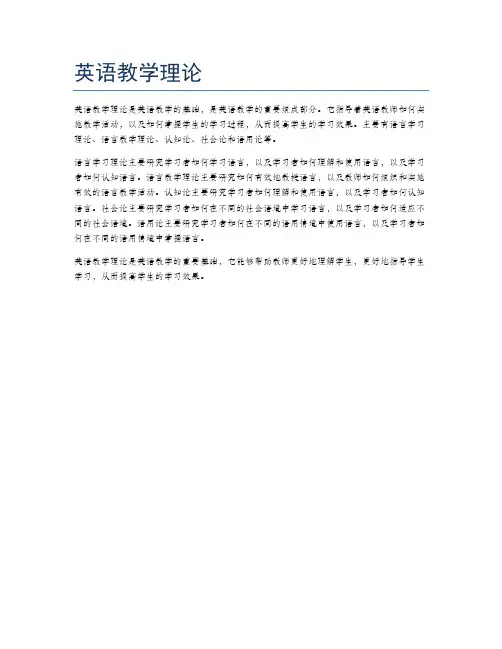
英语教学理论
英语教学理论是英语教学的基础,是英语教学的重要组成部分。
它指导着英语教师如何实施教学活动,以及如何掌握学生的学习过程,从而提高学生的学习效果。
主要有语言学习理论、语言教学理论、认知论、社会论和语用论等。
语言学习理论主要研究学习者如何学习语言,以及学习者如何理解和使用语言,以及学习者如何认知语言。
语言教学理论主要研究如何有效地教授语言,以及教师如何组织和实施有效的语言教学活动。
认知论主要研究学习者如何理解和使用语言,以及学习者如何认知语言。
社会论主要研究学习者如何在不同的社会语境中学习语言,以及学习者如何适应不同的社会语境。
语用论主要研究学习者如何在不同的语用情境中使用语言,以及学习者如何在不同的语用情境中掌握语言。
英语教学理论是英语教学的重要基础,它能够帮助教师更好地理解学生,更好地指导学生学习,从而提高学生的学习效果。
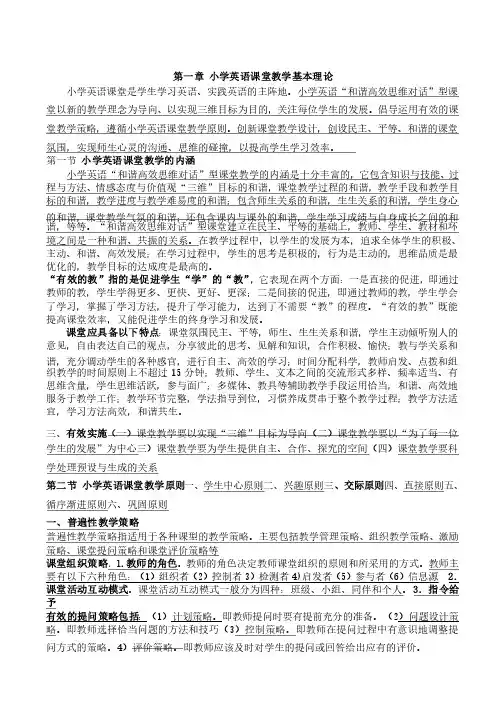
第一章 小学英语课堂教学基本理论小学英语课堂是学生学习英语、实践英语的主阵地。
小学英语“和谐高效思维对话”型课堂以新的教学理念为导向、堂以新的教学理念为导向、以实现三维目标为目的,以实现三维目标为目的,以实现三维目标为目的,关注每位学生的发展。
关注每位学生的发展。
关注每位学生的发展。
倡导运用有效的课倡导运用有效的课堂教学策略,遵循小学英语课堂教学原则。
创新课堂教学设计,创设民主、平等、和谐的课堂氛围,实现师生心灵的沟通、思维的碰撞,以提高学生学习效率。
氛围,实现师生心灵的沟通、思维的碰撞,以提高学生学习效率。
第一节第一节小学英语课堂教学的内涵 小学英语“和谐高效思维对话”型课堂教学的内涵是十分丰富的,小学英语“和谐高效思维对话”型课堂教学的内涵是十分丰富的,它包含知识与技能、它包含知识与技能、过程与方法、程与方法、情感态度与价值观“三维”目标的和谐,情感态度与价值观“三维”目标的和谐,情感态度与价值观“三维”目标的和谐,课堂教学过程的和谐,课堂教学过程的和谐,课堂教学过程的和谐,教学手段和教学目教学手段和教学目标的和谐,教学进度与教学难易度的和谐;包含师生关系的和谐,生生关系的和谐,学生身心的和谐,的和谐,课堂教学气氛的和谐;课堂教学气氛的和谐;课堂教学气氛的和谐;还包含课内与课外的和谐,还包含课内与课外的和谐,还包含课内与课外的和谐,学生学习成绩与自身成长之间的和学生学习成绩与自身成长之间的和谐,等等。
“和谐高效思维对话”型课堂建立在民主、平等的基础上,教师、学生、教材和环境之间是一种和谐、共振的关系。
在教学过程中,以学生的发展为本,追求全体学生的积极、主动、和谐、高效发展;在学习过程中,学生的思考是积极的,行为是主动的,思维品质是最优化的,教学目标的达成度是最高的。
优化的,教学目标的达成度是最高的。
“有效的教”指的是促进学生“学”的“教”,它表现在两个方面:一是直接的促进,即通过教师的教,学生学得更多、更快、更好、更深;二是间接的促进,即通过教师的教,学生学会了学习,掌握了学习方法,提升了学习能力,达到了不需要“教”的程度。
作业1.第2题认为学习外语的目的是通过学习外语培养其阅读文学作品的能力。
为达到此目的,学生必须掌握外语的词汇和语法规则。
A.语法翻译法B.直接法C.认知法D.交际法答案:A标准答案:A您的答案:题目分数:此题得分:2.第3题根据韩礼德对语言的交际功能的分类,如果一个小孩想要他的爸爸带他去公园玩,因此他对爸爸说“Dad, today is Sunday.”而他爸爸听后明白了他的用意,我们可以说,这时候小孩所使用的语言具有___功能。
A.相互关系B.想象C.工具D.描述功能答案:C标准答案:C您的答案:题目分数:此题得分:3.第4题根据Canale 和Swain的交际能力理论,如果一个人具有社会语言能力,那么他那就___。
A.能建立良好的社会关系B.具有较高的社会交际能力C.能根据他所处的社会环境和语言的交际功,恰当地选择语言形式D.知道哪些话语是可行的,哪些话语是不可行的答案:C标准答案:C您的答案:题目分数:此题得分:4.第5题美国结构主义语言学家认为语言可视为一个___的系统,这个系统由结构相关的成分构成。
A.具有生成性B.具有交际功能C.把意义编成了语码D.把语码转换成了意义答案:C标准答案:C您的答案:题目分数:此题得分:5.第6题在“___”模式中,属于语言学习活动的有:1)使用控制性练习帮助学生掌握要学习的结构、词汇和功能;2)使用聚焦语言成分活动练习语言,结合真实性的听力练习加深语言成分在语境使用的认识。
A.强交际派B.弱交际派C.强任务派D.弱任务派答案:D标准答案:D您的答案:题目分数:此题得分:6.第7题该教学方法于十九世纪开始用于教学现代语言,如法语、德语和英语,至今还在许多国家应用。
它是欧洲教授拉丁语和希腊语的传统方法。
A.语法翻译法B.直接法C.情景法D.听说法答案:A标准答案:A您的答案:题目分数:此题得分:7.第8题与情景法一样,在教学法在语言学习理论方面,也是以行为主义的学习理论为依据的。
第1题在该教学法的课堂里,一般来说,教师是命令的发出者,学生则是对命令作出反应的人或者是命令的发出者。
D.全身反应法第2题主张该教学方法的学者认为口语是第一性的,外语学习和母语学习相似,语言学习过程可用联想心理学(associationist psychology)解释。
B.直接法第3题由于在该教学法中使用了语言与行动的结合,从语言学习层面上它还与心理学中的记忆痕迹理论、降低忧虑、紧张有利语言学习等观点有联系。
D.全身反应法第4题在该教学方法的课堂中,声音、简单句子会与教室、家庭、街道等不同环境中的实物和人物等联系进行教学。
B.直接法第5题该教学法又称口语法,是20世纪20年代至60年代期间由英国应用语言学家创立起来的英语教学法。
C.情景法第6题 1966年,美国语言学家乔姆斯基发表了“语言学理论”,认为“___”,语言像人类的其他行为一样,受着规则的支配,且具有生成性。
B.语言不是习惯的结构第7题该教学法的教学活动的特点之一是:教师要求学生在提问或对教师的问题作答时,均以完整的句子说出问句或答句。
A.直接法第8题如果说,在该教学法的第二阶段中,练习是紧扣课文、围绕课文的语言点进行,并且控制性较大的话,那么,在该教学法的第三阶段中,教学活动应该是控制性不很大,使学生享有更大自主权的交际性练习。
B.认知法第9题根据克拉申(S. Krashen)的情感过滤假设,语言输入在进入大脑中的“语言习得机制”(LAD)的时候,会受到___的影响。
B.自信心、焦虑程度和动机第10题在“___”模式中,属于语言学习活动的有:1)在聚焦语言阶段使用增强意识活动,让学生在教师指导下分析和发现语言特点;2)之后,设计练习让学生练习语言点。
C.强任务派第11题该教学法的三个原则包括:交际性原则、任务性原则和意义原则。
B.交际法第12题该教学法的创始人Asher把刺激—反应看作语言教学方法的学习理论。
因此,我们可以认为,该教学法体现了以语法为基础的语言观和行为主义的语言学习观。
张伊那语言教学理论和实践7月12日内容第一讲语言观与语言学习观思考题:什么是语言?外语教学教什么?第一代:传统语言教学无自觉的语言观,想当然的把语言做为一门知识教。
包括语法知识、词汇、知识和语音知识第二代:结构主义语言观语言是一套形式结构,一套符号系统受行为主义心理学的影响,人们认为,学语言就是要获得操作这套符号系统的技能,用行为主义心理学的术语说,就是训练对刺激作出正确反映的一套语言习惯。
因而,教学一门语言就是通过反复几次训练学生正确操作这门语言的(即一套形式系统)的各种技能。
第三代:交流语言观不仅是以上两种,而是获取人与人交际的一种能力。
能力不排除知识和技能,但是也不等于知识和技能,而是把知识和技能包含进去的,性质起了变化的综合体。
教语言不能停留于教知识、教技能,而要培养能力。
思考题:何为交际能力?交际能力大于语言能力,且包含语言能力交际能力有三个范畴的能力(包含知识、技能、能力)组成:1.语言能力:语言形式结构系统本身的操作能力2.语篇能力:语言形式结构置于语篇中运用的能力3.语用能力:语言形式结构置于情境中运用的能力思考题:交际语言观对语言教学的启示?语言教学必须注意培养以下三个范畴的能力1.语言、语法、词汇知识、词和句的语义知识,听、说、读、写的技能2.语篇规则的知识,语篇组织能力,语篇连接策略等3.实现语言功能的能力、交际策略、社会语言能力、社会文化知识、关于世界的知识等《英语课程标准》所体现的语言观“语言是人类最重要的思维和句,也是人们参与社会的重要条件。
语言对促进人的全面发展具有重要意义。
”“高中学生学习外语,一方面可以促进心智、情感、态度与价值观的发展和综恩问素养的提高;另一方面,掌握一门国际通用语种可以为学习国外先进的文化科学、技术和进行国际交往创造条件。
“注:语言的工具性和人文性有机结合,高度统一。
工具性与人文性也是教育的两大功能。
思考题:人们是如何学习语言的?历史上形形色色的外语学习理论可归结为两个方面相反的主要趋向:1.把人学习外语外语看作是一套心理生理习惯的形成,这是通过模仿和刺激反应的技能训练2.认为人学习外语是在自己的脑子里构造一套新的知识(陈述性知识和程序性知识)系统,这构造的过程强调创造性及认知和情感机能的作用。
作业1.第3题如果说,在该教学法的第二阶段中,练习是紧扣课文、围绕课文的语言点进行,并且控制性较大的话,那么,在该教学法的第三阶段中,教学活动应该是控制性不很大,使学生享有更大自主权的交际性练习。
A.直接法B.认知法C.交际法D.全身反应法答案:B标准答案:B您的答案:题目分数:4.0此题得分:0.02.第4题该教学法的三个原则包括:交际性原则、任务性原则和意义原则。
A.认知法B.交际法C.全身反应法D.任务型语言教学模式答案:B标准答案:B您的答案:题目分数:4.0此题得分:0.03.第5题主张该教学方法的学者认为口语是第一性的,外语学习和母语学习相似,语言学习过程可用联想心理学(associationist psychology)解释。
A.语法翻译法B.直接法C.情景法D.听说法答案:B标准答案:B您的答案:题目分数:4.0此题得分:0.04.第6题该教学法是指在语言教学中使用“任务”作为教学核心单位的语言教学途径。
它可视为交际法在教学方面的发展。
A.认知法B.交际法C.全身反应法D.任务型语言教学模式答案:D标准答案:D您的答案:题目分数:4.0此题得分:0.05.第7题尽管该教学方法可以分为两种派别,但我们会发现在他们的教学中都包含两种活动类型:任务型活动和语言学习活动。
A.认知法B.交际法C.全身反应法D.任务型语言教学模式答案:D标准答案:D您的答案:题目分数:4.0此题得分:0.06.第8题在该教学法中,学生使用目标语完成社会中出现的各类任务。
在学习过程中他们通过语言互动进行交际;在大量的听、说、读和写的活动中使用语言和语言运用策略交流,最终培养起用目标语在社会活动中做事的能力。
因此,可以说,该教学方法强调通过使用目标语互动达到培养交际能力的目的。
A.认知法B.交际法C.全身反应法D.任务型语言教学模式答案:D标准答案:D您的答案:题目分数:4.0此题得分:0.07.第9题该教学法的教学步骤被威利斯(Willis,1996)描述为:Pre-task(任务前阶段)、Task cycle(任务中阶段) 和Language focus(聚焦语言阶段)。
第1篇Introduction:The aim of this report is to provide a comprehensive overview of English teaching theory and practice. It will explore various theories that underpin English language teaching, discuss the implementation of these theories in the classroom, and reflect on the effectiveness of different teaching methods. The report will also highlight the challenges faced by English teachers and propose strategies to overcome them.I. English Teaching Theories1. Behaviorist TheoryBehaviorist theory, proposed by B.F. Skinner, emphasizes the role of repetition and reinforcement in language learning. According to this theory, language is acquired through a series of conditioned responses. Teachers can implement this theory by providing clear instructions,using repetition drills, and offering positive reinforcement to encourage student participation.2. Cognitive TheoryCognitive theory, developed by Noam Chomsky, focuses on the mental processes involved in language acquisition. This theory suggests that learners construct their own internal grammar and acquire language through interaction with the environment. Teachers can utilize this theory by promoting critical thinking, encouraging students to analyze language structures, and providing opportunities for meaningful communication.3. Sociocultural TheorySociocultural theory, proposed by Lev Vygotsky, emphasizes the importance of social interaction and cultural context in language learning. This theory suggests that learners acquire language through collaboration with others and by internalizing cultural norms. Teachers can implement this theory by creating a supportive classroom environment,encouraging group work, and integrating cultural activities into the curriculum.4. Humanistic TheoryHumanistic theory, developed by Carl Rogers, emphasizes the importanceof the individual's personal growth and self-actualization in language learning. This theory suggests that learners are motivated by intrinsic factors and that teachers should focus on creating a positive,supportive classroom atmosphere. Teachers can implement this theory by encouraging student autonomy, promoting self-reflection, and valuing student feedback.II. Implementation of English Teaching Theories in the Classroom1. Behaviorist ApproachIn a behaviorist classroom, teachers can use techniques such as direct instruction, repetition drills, and positive reinforcement to facilitate language learning. For example, teachers can use a grammar workbook to introduce new structures, followed by controlled practice and corrective feedback to ensure students internalize the language.2. Cognitive ApproachA cognitive classroom encourages students to actively engage with the language, analyze its structures, and make connections with theirexisting knowledge. Teachers can use activities such as vocabulary games, reading comprehension exercises, and writing prompts to promote critical thinking and language development.3. Sociocultural ApproachIn a sociocultural classroom, teachers can foster collaboration and cultural awareness through activities such as group projects, cultural exchange programs, and language games. By encouraging students tointeract with peers from different backgrounds, teachers can promote language acquisition and cultural understanding.4. Humanistic ApproachA humanistic classroom focuses on creating a supportive environment that allows students to explore their own identities and express themselves. Teachers can use techniques such as open-ended discussions, reflection activities, and peer assessment to promote student autonomy and self-awareness.III. Challenges and Strategies1. Language BarriersOne of the primary challenges in English language teaching is overcoming language barriers. To address this, teachers can use simple language, visual aids, and gestures to convey their messages effectively. Additionally, providing opportunities for students to practice their speaking and listening skills in a supportive environment can help bridge the language gap.2. Diverse Learning StylesStudents have varying learning styles, which can make it challenging to cater to all learners. To overcome this, teachers can use a variety of teaching methods, such as visual, auditory, and kinesthetic approaches, to engage different types of learners. By incorporating activities that cater to diverse learning styles, teachers can create a more inclusive classroom environment.3. MotivationMaintaining student motivation can be challenging, especially in a language learning context. To address this, teachers can create engaging and relevant lessons, incorporate real-life contexts, and offer opportunities for student choice and autonomy. By making the learning process enjoyable and meaningful, teachers can foster a positiveattitude towards language learning.Conclusion:This report has provided an overview of English teaching theory and practice, highlighting the importance of understanding different theories and their application in the classroom. By incorporatingvarious teaching methods and addressing the challenges faced by English teachers, educators can create an effective and engaging learning environment that promotes language acquisition and personal growth.第2篇IntroductionEnglish language teaching (ELT) has evolved significantly over the years, with various theories and practices shaping the way educators approach the classroom. This report aims to provide a comprehensive overview of key ELT theories and their practical application in the classroom. By examining these theories and practices, we can gain insights into how to create effective and engaging learning environments for English language learners (ELLs).1. Theoretical Frameworks in English Language Teaching1.1 BehaviorismBehaviorism, founded by B.F. Skinner, suggests that learning is a result of behavior modification through reinforcement and punishment. In the context of ELT, behaviorist approaches focus on creating controlled environments where students can practice and perfect their languageskills through repetition and positive reinforcement.1.2 Cognitive DevelopmentCognitive development theory, proposed by Jean Piaget, emphasizes the importance of learners' mental processes in language acquisition. This theory highlights the stages of cognitive development that learners go through, and suggests that teachers should adapt their teaching methods to cater to these stages.1.3 Communicative Language Teaching (CLT)Communicative Language Teaching (CLT) is an approach that focuses on communication as the primary goal of language learning. This theory emphasizes the importance of real-life communication tasks, interaction, and the development of fluency and accuracy. Teachers using CLT oftenemploy techniques such as role-plays, discussions, and group work to promote communication skills.1.4 Task-Based Language Teaching (TBLT)Task-Based Language Teaching (TBLT) is a method that organizes language learning around tasks that learners are likely to encounter in real-life situations. This approach emphasizes the importance of task completion and focuses on the meaning of language rather than just the form. Teachers using TBLT design tasks that require students to use the language in context.1.5 Sociocultural TheorySociocultural theory, proposed by Lev Vygotsky, suggests that learning is a social process that occurs through interaction with others. This theory emphasizes the importance of the cultural context in which learning takes place and the role of the teacher as a facilitator of learning.2. Practical Application of Theories in the Classroom2.1 Behaviorist ApproachIn a behaviorist classroom, teachers can use techniques such as the following:- Direct instruction: Presenting new language structures and vocabulary through explicit teaching.- Drilling: Repeating exercises and activities to reinforce language patterns and structures.- Positive reinforcement: Providing praise and rewards for correct responses and progress.2.2 Cognitive Development ApproachTo apply cognitive development theory in the classroom, teachers can:- Adjust teaching methods to cater to different stages of cognitive development.- Use scaffolding techniques to guide learners through complex tasks.- Provide opportunities for learners to engage in problem-solving activities.2.3 Communicative Language Teaching (CLT)Implementing CLT in the classroom involves:- Designing activities that promote interaction and communication.- Encouraging learners to use the target language in real-life contexts.- Providing opportunities for learners to practice speaking, listening, reading, and writing skills.2.4 Task-Based Language Teaching (TBLT)Incorporating TBLT into the classroom can be achieved through:- Designing tasks that are meaningful and relevant to learners' lives.- Ensuring that tasks require learners to use the target language in context.- Providing feedback and assessment based on task completion and language use.2.5 Sociocultural TheoryApplying sociocultural theory in the classroom includes:- Creating a supportive and collaborative learning environment.- Encouraging learners to interact with peers and share their cultural perspectives.- Facilitating the development of learners' metacognitive skills through guided instruction.3. ConclusionThis report has explored various ELT theories and their practical application in the classroom. By understanding these theories andimplementing their corresponding practices, teachers can createeffective and engaging learning environments for their students. As language learning continues to evolve, it is crucial for educators to stay informed about new theories and methods to ensure that their teaching practices remain relevant and effective.第3篇IntroductionThis report aims to provide an in-depth analysis of English teaching theory and its practical application in the classroom. It explores various theoretical frameworks that guide English language teaching, discusses their implications for classroom practice, and presents a case study of a teaching intervention that integrates these theories.Theoretical Frameworks in English Language Teaching1. Theoretical Approaches to Language Learninga. Behaviorism: This approach, rooted in B.F. Skinner's work, suggests that language is a system of stimulus-response relationships. Teachers can use this theory to design activities that reinforce correct language use.b. Cognitive Approach: Proposed by scholars like Krashen, this approach emphasizes the role of mental processes in language learning.It suggests that learners construct their knowledge of language through interaction and meaningful communication.c. Sociocultural Approach: Based on the work of Vygotsky, this theory highlights the importance of social interaction and cultural context in language learning. It suggests that language is a tool for social interaction and cognitive development.2. Theories of Language Teachinga. The Direct Method: This method, popularized by the oralists, emphasizes the use of the target language in the classroom. It focuseson conversational practice and the development of pronunciation and intonation.b. The Audio-Lingual Method: Also known as the Structural Approach, this method focuses on the systematic presentation and practice of grammatical structures. It uses repetition and rote learning tofacilitate language acquisition.c. The Communicative Approach: This approach, developed in the 1970s, emphasizes communication and interaction as the primary goals of language learning. It encourages teachers to design activities that promote meaningful and purposeful communication.3. Curriculum Development and Assessmenta. Curriculum Development: The curriculum should be designed to meet the needs and interests of learners, as well as the goals of the educational institution. It should incorporate a variety of teaching and learning activities, resources, and assessment methods.b. Assessment: Assessment should be used to evaluate learners' progress and inform teaching decisions. It should be formative, as well as summative, and should include both quantitative and qualitative measures.Practical Application in the ClassroomThe following case study illustrates how a teacher can integrate various theoretical frameworks into classroom practice.Case Study: Integrating Theoretical Frameworks into Classroom PracticeTeacher: Ms. JohnsonGrade Level: 8th GradeSubject: English Language ArtsContext: Ms. Johnson teaches an 8th-grade English class at a public school in a suburban area. The students come from diverse cultural backgrounds and have varying levels of English proficiency.Teaching Intervention1. Behaviorism: Ms. Johnson uses positive reinforcement to encourage students to participate in class discussions. She rewards students who volunteer to answer questions or share their thoughts with stickers or verbal praise.2. Cognitive Approach: To develop students' critical thinking skills, Ms. Johnson designs activities that require students to analyze and evaluate texts. For example, she asks students to compare and contrast characters in a novel and explain their similarities and differences.3. Sociocultural Approach: Ms. Johnson incorporates cultural activities into her lessons to promote understanding and appreciation of diverse cultures. For instance, she organizes a cultural fair where students showcase their heritage and share stories about their families.4. Direct Method: Ms. Johnson uses the target language extensively inher lessons. She encourages students to speak English during class discussions and provides opportunities for them to practice their listening and speaking skills.5. Communicative Approach: Ms. Johnson designs activities that promote meaningful communication. For example, she organizes group projects where students work together to create a presentation on a given topic.AssessmentMs. Johnson uses a variety of assessment methods to evaluate herstudents' progress. These include:- Quizzes and tests to measure students' knowledge of grammar and vocabulary.- Oral presentations to assess students' speaking and listening skills.- Writing assignments to evaluate students' writing abilities.- Portfolios to track students' progress over time.ConclusionThis report has explored various theoretical frameworks in English language teaching and their practical application in the classroom. By integrating these theories into their teaching practice, teachers can create a more engaging and effective learning environment for their students. The case study presented demonstrates how a teacher can successfully implement these theories to enhance students' language learning experiences.。
第1题在该教学法的课堂里,一般来说,教师是命令的发出者,学生则是对命令作出反应的人或者是命令的发出者。
D.全身反应法第2题主张该教学方法的学者认为口语是第一性的,外语学习和母语学习相似,语言学习过程可用联想心理学(associationist psychology)解释。
B.直接法第3题由于在该教学法中使用了语言与行动的结合,从语言学习层面上它还与心理学中的记忆痕迹理论、降低忧虑、紧张有利语言学习等观点有联系。
D.全身反应法第4题在该教学方法的课堂中,声音、简单句子会与教室、家庭、街道等不同环境中的实物和人物等联系进行教学。
B.直接法第5题该教学法又称口语法,是20世纪20年代至60年代期间由英国应用语言学家创立起来的英语教学法。
C.情景法第6题 1966年,美国语言学家乔姆斯基发表了“语言学理论”,认为“___”,语言像人类的其他行为一样,受着规则的支配,且具有生成性。
B.语言不是习惯的结构第7题该教学法的教学活动的特点之一是:教师要求学生在提问或对教师的问题作答时,均以完整的句子说出问句或答句。
A.直接法第8题如果说,在该教学法的第二阶段中,练习是紧扣课文、围绕课文的语言点进行,并且控制性较大的话,那么,在该教学法的第三阶段中,教学活动应该是控制性不很大,使学生享有更大自主权的交际性练习。
B.认知法第9题根据克拉申(S. Krashen)的情感过滤假设,语言输入在进入大脑中的“语言习得机制”(LAD)的时候,会受到___的影响。
B.自信心、焦虑程度和动机第10题在“___”模式中,属于语言学习活动的有:1)在聚焦语言阶段使用增强意识活动,让学生在教师指导下分析和发现语言特点;2)之后,设计练习让学生练习语言点。
C.强任务派第11题该教学法的三个原则包括:交际性原则、任务性原则和意义原则。
B.交际法第12题该教学法的创始人Asher把刺激—反应看作语言教学方法的学习理论。
因此,我们可以认为,该教学法体现了以语法为基础的语言观和行为主义的语言学习观。
D.全身反应法第13题该教学方法于十九世纪开始用于教学现代语言,如法语、德语和英语,至今还在许多国家应用。
它是欧洲教授拉丁语和希腊语的传统方法。
A.语法翻译法第14题在该教学法的课堂中,由于语言学习被视为习惯的培养,教师会要求学生重复某些语言结构以加快习惯的养成。
故此,句型操练和“逆向组句法”在该教学法中被视为一种有效的方法。
D.听说法第15题在该教学法的语言理解阶段,教师提供易于使学生发现规则的语言材料,学生要理解教师讲授或提供的材料,发现和总结语法规则。
C.认知法第16题在“___”模式中,属于任务活动的有:1) 在任务前阶段激活相关图式(背景知识)及已掌握的语言结构及词汇;2)在任务中阶段分组进行真实性的交际活动,之后作准备并把结果汇报。
C.强任务派第17题英语教学法研究英语的教与学,目的在于探讨英语教学的内部规律,从而为更好、更快、更有效地教授和学习英语提供良好的教材。
答案:错误第18题到了十九世纪中期,由于相互间口头交际需要的增加,欧洲人越来越发现语法——翻译法的不足,他们注意到小孩在学习母语时的特点和一些较普遍的现象,他们想借助小孩学习母语的模式去进行外语教学。
答案:正确第19题外语教学的目的不但要培养学生掌握语言结构,而且要培养他们懂得对什么人、在什么时候、在什么场合使用这些结构和运用语言。
答案:正确第20题在新中国成立后很长的一段时间里,中国外语教学的基本路子是任务型教学法。
答案:错误第21题在十九世纪末二十世纪初,英国学者在总结前人经验的基础上,在语言方面进行了有效果的研究工作,最后创立了一整套教学法理论的原则:即选择性原则、分级原则和授课原则。
这些原则就构成了情景法的基础。
答案:正确第22题很多英、美学者都认为交际法不是一种特别的方法,而是一种学习外语的途径,它的目的在于培养学习者的语言能力。
答案:错误第23题在二十世纪七十年代初期,美国的海姆斯针对乔姆斯基的语言能力提出了他的“交际能力”概念,以表述语言在社会的使用。
答案:正确第24题由于我们知道语言环境对语言学习是很重要的,因此,我们应考虑如何为英语教学创造更好的环境,向学习者提供更多的语言输入,以使他们能更好、更快地掌握英语。
答案:正确第25题 1888年,国际音标问世,这使人们能把有声的语言用书面的方式记录下来,为教授语言结构提供了有用的工具。
答案:错误第26题语言是个具有单层面结构的、具有生成性的系统。
答案:错误第27题认知法强调在理解语言规则的基础上进行机械操练。
答案:错误第28题由于对语言形式、语法和学习过程的不同理解,在主张交际法的学者中对语法、语言结构的作用和如何教学存在不同的观点。
有学者把交际法分为传统交际法和现代交际法。
答案:错误第29题“强任务派”主张在完成任务之后才按学习者的需要进行语言分析和练习,分析也应使用意识提升活动(consciousness raising);“弱任务派”则认为任务型语言教学课堂过程与传统的PPP (Presentation-Practice-Production)并无太大不同。
答案:正确第30题该教学法的教学步骤被威利斯(Willis,1996)描述为:Pre-task(任务前阶段)、Task cycle(任务中阶段) 和Language focus(聚焦语言阶段)。
D.任务型语言教学模式第31题在该教学法中,学生使用目标语完成社会中出现的各类任务。
在学习过程中他们通过语言互动进行交际;在大量的听、说、读和写的活动中使用语言和语言运用策略交流,最终培养起用目标语在社会活动中做事的能力。
因此,可以说,该教学方法强调通过使用目标语互动达到培养交际能力的目的。
D.任务型语言教学模式第31题在该教学方法中,语言学习被视作智力活动,这种活动涉及规则学习、规则的记忆和以大量翻译的方式与母语意义相联系的操作。
A.语法翻译法第32题该教学法的教学步骤常常是:1)教师用母语简单介绍文章的作者和写作背景,并对文章的大意进行译述。
2)教师带读单词表里的单词。
3)教师对课文逐句地翻译。
4)让学生直接阅读课文,并做一些阅读理解的练习。
5)布置学生做一些笔头的翻译练习。
A.语法翻译法第33题在该教学法的课堂里,准交际活动是为真实交际作准备而设计的教学活动。
准交际活动可以是句型操练、对话等项目,目的是对外语中的句型和结构进行训练,为交际活动作好准备。
C.交际法第34题在“___”模式中,属于语言学习活动的有:1)在聚焦语言阶段使用增强意识活动,让学生在教师指导下分析和发现语言特点;2)之后,设计练习让学生练习语言点。
C.强任务派第35题该教学法认为,对学习者有意义的语言能促进语言学习。
D.任务型语言教学模式第36题主张该教学方法的学者认为口语是第一性的,外语学习和母语学习相似,语言学习过程可用联想心理学(associationist psychology)解释。
B.直接法第37题该教学法的创始人Asher认为目标语的大部分语言结构以及数以百计的词汇项目都可以通过教师技巧地使用祈使句来教授。
C.全身反应法第38题该教学法又称口语法,是20世纪20年代至60年代期间由英国应用语言学家创立起来的英语教学法。
C.情景法第39题采用该教学法的教师会对课文中的语法规则作演绎式的讲解。
A.语法翻译法第40题按该教学法原则编写的典型教材有《新概念英语》。
B.直接法第41题乔姆斯基(Chomsky)提出的转换生成语法和心理语言学是该教学方法的语言和语言学习理论基础。
A.认知法第42题英国学者Palmer指出学习语言有三个过程,即接受语言输入,通过重复操练记住并在实际练习中使之变为个人技能。
很明显,行为主义的习惯形成理论是该教学法的语言学习观。
C.情景法第43题该教学法的特点包括强调交际中意义的传递和语言的使用。
B.交际法第44题认为外语教学应与母语脱钩,因此,在采用该教学法进行教学的课堂里,母语是避免使用的。
C.交际法第45题该教学法主张全外语教学,母语在外语课堂中不应该使用。
B.直接法第46题该教学法的三个原则包括:交际性原则、任务性原则和意义原则。
B.交际法第47题在该教学法的课堂里,一般来说,教师是命令的发出者,学生则是对命令作出反应的人或者是命令的发出者。
D.全身反应法第48题在该教学法的语言理解阶段,教师提供易于使学生发现规则的语言材料,学生要理解教师讲授或提供的材料,发现和总结语法规则。
C.认知法第49题提倡该教学法的英国学者亚历山大把教学活动总结概括为:提出情景,学习语言;听说领先,反复操练;书面练习,巩固结构。
C.情景法第50题主张这种教学法的学者认为:母语将会成为学习外语的障碍,干扰外语的学习。
因此,该教学法主张全外语的教学,母语在外语课堂中不应该使用。
A.语法翻译法第51题在美国,当时的许多学者把语言看做一个系统,这系统由在结构上相互联系用以表义的成分组成,这些成分是音素、词素、单词、结构和句型。
因此,该教学法在语言学理论方面是以结构主义作为其理论基础的。
D.听说法第52题尽管该教学方法可以分为两种派别,但我们会发现在他们的教学中都包含两种活动类型:任务型活动和语言学习活动。
D.任务型语言教学模式第53题在该教学方法中,教师要根据学生的需要、兴趣及语言学习水平选择、改编或编写好任务并决定教学的顺序。
从这个意义来说,教师是任务的选择者和决定者。
D.任务型语言教学模式第54题在该教学法的课堂中,由于语言学习被视为习惯的培养,教师会要求学生重复某些语言结构以加快习惯的养成。
故此,句型操练和“逆向组句法”在该教学法中被视为一种有效的方法。
D.听说法第55题该教学方法是在十九世纪末作为语法翻译法的批判而创立的外语教学的一种方法。
它的特点包括:1)只使用目标语进行教学;2)意义通过语言、动作、物体等手段结合情景表达;3)先教说,然后教读、写;4)用归纳法讲授语法。
B.直接法第56题该教学法的教学步骤被奴南(Nunan,2004)描述为:1. Schema building(图式的建立); 2. Controlled practice (控制性练习);3. Authentic listening practice(真实性听力练习);4. Focus on linguistic elements(聚焦语言成分);5. Provide freer practice(更灵活的练习;6. Introduce the pedagogical task(引入教学任务)。
D.任务型语言教学模式第57题在“___”模式中,属于语言学习活动的有:1)使用控制性练习帮助学生掌握要学习的结构、词汇和功能;2)使用聚焦语言成分活动练习语言,结合真实性的听力练习加深语言成分在语境使用的认识。